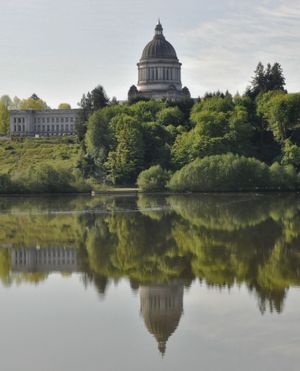Legislature may be 300 miles away but you can keep tabs on them
Keeping an eye on the Washington Legislature, which can feature competing floor sessions or dawn-to-dusk committee hearings, is challenging in Olympia, but even more difficult for Spokane residents some 300 miles away.
Difficult, but not impossible. The Internet and other technology make it easier than a generation ago, both for reporters in Olympia and for readers at home. Here are a few tricks of the trade used by the capital press corps:
Catch it live. Even from Spokane you can watch many floor debates and some committee meetings live, either on the cable television feed for TVW (Channel 25 on Comcast in Spokane) or, if your Internet connection is reasonably fast, on its website, tvw.org. TVW has a daily schedule on the website both for television and for webcasts.
When both houses are involved in floor action, the one that’s not on cable television is being carried on the website. When the chamber that’s on television takes a break – which happens sometimes without much warning and for an unpredictable length of time – the television feed switches to the other chamber. How to tell them apart? If the vote is being recorded on a board, it’s the House; if members are standing up to voice their “yeas” or “nays” it’s the Senate.
Legislative committees are expected to expand the chances to offer remote testimony, saving interested citizens the trip across a mountain pass or the cost of a plane ticket. Spin Control will try to flag opportunities for remote testimony in the Spokane area.
Catch it later. While most people have seen TVW broadcasts while flipping through the cable channels, not as many are familiar with the network’s online archive system. It saves floor sessions by date and hearings for nearly every House and Senate committee. The hearings are arranged by day and committee, and list at least some of the bills discussed. It’s possible to search for hearings or action on a bill by its number. Video of a hearing usually shows up on the site a few hours after it concludes.
Use the state resources. You pay for them so get your money’s worth. The Legislature’s website, leg.wa.gov, offers a wealth of information beyond phone numbers and addresses for lawmakers. The home page has a link on the left side for the bill information page, which is great for tracking legislation. If you know the bill number, enter it into the search window. You’ll get the legislative history, including vote counts, and links to the original bill and its changes.
If you don’t know the number, click on “search the full text of a bill,” which goes to an advanced search engine that allows you to find bills or statutes by topic for this and several past sessions. Check the box for “All Bills, Memorials and Resolutions” for the broadest search of session activity.
To get daily and weekly lists of hearings, click on “Sign Up for Updates” from the Legislature’s home page. The lists also show which sessions are expected to be broadcast live. TVW also webcasts several committee hearings live when the meeting schedule is packed, as it often is during the first month of the session.
To find out how much money is being spent and where it goes, use the site maintained by the Legislative Evaluation and Accountability Program at leap.leg.wa.gov. It shows the current budgets for state operations, capital projects and transportation, as well as past budgets since 1979. When new budgets are proposed, they go on the LEAP site.
Budget breakdowns also show up on fiscal.wa.gov, which is good for comparing spending for current things like public schools or government operations or natural resources with what each chamber proposed and passed. Users can search for state employee salaries by name or department, and another maps spending on transportation and capital construction projects by county and legislative district.
Use other websites. The caucuses in each chamber have their own blogs that tout the wonderful things their members are doing, with news releases and video clips. House Republicans have the Capitol Buzz, House Democrats the Advance, Senate Democrats the Hopper and Senate Republicans have Washington SRC.
All can be found from the main legislative site. There’s a fair amount of fluff, and for a balanced view on a controversial topic you’ll want to check all sides.
Washington Votes has a good search engine for tracking which bills legislators introduce and support.
You can find running commentary from lawmakers, the caucus staffs, the press corps and other elected officials or their staffs on things happening in and around the Legislature on Twitter by searching #WaLeg. If you want to know what lawmakers in your district are doing, check to see if they have Twitter or Facebook accounts (it’s 2017, most do) and follow or friend them.
The Spokesman-Review will collect stories and columns about this year’s session on spokesman.com with a 2017 Washington Legislature tag.
Washington State Wire, covers state government with a pro-business slant. For an opposing view, The Stand, the state Labor Council’s blog which mixes in some state news and commentary.
